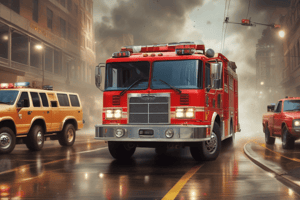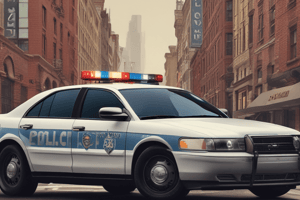Podcast
Questions and Answers
Under which specific circumstances are JFRD vehicles explicitly authorized to exceed posted speed limits?
Under which specific circumstances are JFRD vehicles explicitly authorized to exceed posted speed limits?
- When responding to alarms or transporting a patient to a medical facility, provided that favorable conditions are present. (correct)
- During periods of inclement weather where reduced visibility necessitates a faster response to mitigate potential hazards.
- When directed by a supervising officer to expedite arrival at the scene of a confirmed structure fire.
- During civil unrest where the safety of JFRD personnel is threatened and a swift exit is required.
What is the MOST critical consideration for the operator of a JFRD vehicle when positioning the apparatus at an incident scene?
What is the MOST critical consideration for the operator of a JFRD vehicle when positioning the apparatus at an incident scene?
- Ensuring the apparatus is readily accessible to incoming mutual aid resources from neighboring jurisdictions.
- Positioning the apparatus to protect personnel while ensuring it does not unnecessarily impede traffic or interfere with equipment removal. (correct)
- Minimizing the distance between the apparatus and the designated command post to facilitate communication.
- Maximizing the visibility of the apparatus to serve as a visual deterrent to unauthorized civilian access to the incident area.
In the procedural framework governing JFRD vehicle operations, what stipulation applies to situations where an operator must traverse a negative right-of-way intersection (e.g., controlled by a red light or stop sign)?
In the procedural framework governing JFRD vehicle operations, what stipulation applies to situations where an operator must traverse a negative right-of-way intersection (e.g., controlled by a red light or stop sign)?
- The operator must execute a complete stop and undertake a comprehensive assessment of all lanes to account for all traffic before proceeding. (correct)
- The operator should contact dispatch to temporarily halt cross-traffic.
- The operator may cautiously proceed through the intersection, ensuring that cross-traffic yields the right-of-way in accordance with implied emergency vehicle protocols.
- The operator must activate the vehicle's emergency signal preemption system to automatically halt conflicting traffic flows.
According to JFRD's Standard Operating Guidelines, which action is MANDATORY before a JFRD vehicle is permitted to move from its stationary position?
According to JFRD's Standard Operating Guidelines, which action is MANDATORY before a JFRD vehicle is permitted to move from its stationary position?
What is the prescribed protocol for a JFRD vehicle operator encountering a school bus displaying its 'STOP' signal, irrespective of the unit's response status?
What is the prescribed protocol for a JFRD vehicle operator encountering a school bus displaying its 'STOP' signal, irrespective of the unit's response status?
What specific stipulation governs the permissible actions of JFRD personnel preparing to dismount from an apparatus at an incident?
What specific stipulation governs the permissible actions of JFRD personnel preparing to dismount from an apparatus at an incident?
According to JFRD's operational guidelines, during which hours should siren usage be most restricted, and what overarching principle governs this restriction?
According to JFRD's operational guidelines, during which hours should siren usage be most restricted, and what overarching principle governs this restriction?
Within the context of JFRD's operational framework, what is the designated procedure for reporting defects, discrepancies, or unsafe conditions identified during the daily apparatus inspection process?
Within the context of JFRD's operational framework, what is the designated procedure for reporting defects, discrepancies, or unsafe conditions identified during the daily apparatus inspection process?
What action is required of the Company Officer when a spare JFRD unit is returned after normal working hours?
What action is required of the Company Officer when a spare JFRD unit is returned after normal working hours?
Under what specific circumstance are personnel permitted to be unbelted in a moving JFRD vehicle?
Under what specific circumstance are personnel permitted to be unbelted in a moving JFRD vehicle?
Flashcards
Priority of Arrival
Priority of Arrival
Safe arrival should always be prioritized over speedy arrival when operating JFRD vehicles.
Attaining Safe Response
Attaining Safe Response
Prompt, safe response is achieved by quickly mounting vehicles; ensuring all personnel are onboard, seated, and have seatbelts fastened; waiting for bay doors to open completely; leaving the station in a standard manner; knowing the route to be taken; driving defensively and professionally at reasonable speeds; and using audible warning devices when necessary.
Seat Belt Policy
Seat Belt Policy
All City of Jacksonville employees and passengers are required to use seat belts before the vehicle is permitted to move.
Backing JFRD Vehicles
Backing JFRD Vehicles
Signup and view all the flashcards
Warning Devices Use
Warning Devices Use
Signup and view all the flashcards
Exceeding Speed Limits
Exceeding Speed Limits
Signup and view all the flashcards
Negative Right-of-Way
Negative Right-of-Way
Signup and view all the flashcards
Dismounting Apparatus
Dismounting Apparatus
Signup and view all the flashcards
Fuel Supply
Fuel Supply
Signup and view all the flashcards
Daily Vehicle Inspection
Daily Vehicle Inspection
Signup and view all the flashcards
Study Notes
- JFRD's Standard Operating Guidelines (SOG) number 402 is for Vehicle Operations
- SOG 402 aims to ensure the safety of JFRD personnel and the public
Policy
- Safe arrival is the priority
- Prompt, safe response involves:
- Quickly mounting vehicles
- All personnel onboard, seated, and seatbelts fastened
- Waiting for bay doors to fully open
- Leaving the station in a standard manner
- Route knowledge
- Driving defensively and professionally at reasonable speeds
- Utilizing audible warning devices when needed
Responsibility
- JFRD vehicles must be operated following Florida driving statutes
- Operators must drive with due caution, even during emergencies
- The vehicle operator is responsible for safe operations
- The Company Officer ensures the operator follows all laws and procedures for emergency vehicle operations
- Operators must report any condition that may impair their ability to safely operate a JFRD vehicle to the Company Officer
Seatbelts
- All City of Jacksonville employees and passengers must use seat belts
- Before moving, the Company Officer confirms all personnel are onboard, wearing seatbelts and PPE if needed
- The number of personnel in a JFRD vehicle is limited to the number of seat belts
- Personnel are only allowed to ride in seats equipped with seatbelts
- Riding tailboards or other exposed positions is prohibited
- Protective equipment should not be donned while the vehicle is moving unless properly seated and seat belted
- Only personnel engaged in patient care who need to stand or kneel are allowed to be unbelted in a moving vehicle
Apparatus Inspection
- Engineers/operators inspect their assigned vehicle daily to assess its condition
- The inspection includes checking the water level of booster tanks and other fluid levels
- The Engineer's Daily Apparatus Report must then be completed and signed
- Defects, discrepancies, irregularities, or unsafe conditions must be immediately reported to the Company Officer
- The Company Officer then must contact Tactical Support personnel for guidance
- Firefighting and EMS equipment should be inspected daily and before leaving emergency scenes
- Maintenance and general cleaning are also performed daily
- Vehicle motors should be allowed to reach normal operating temperature before shutting off
- A more thorough inspection of the apparatus and all equipment should be performed every Monday
Spare Units
- The Company Officer is responsible for spare units and their equipment when assigned
- Spare units must be fueled and cleaned upon return
- Tactical Support personnel should be notified of any necessary repairs
- If returned after hours, the Company Officer notifies FRCC of the unit's location and repair needs
General Guidelines
- The fuel supply should be refilled when it goes below 3/4 full, unless at an emergency scene, where refueling should occur as soon as practical
Private Driveways
- Fire apparatus should not be driven on private driveways or over privately owned bridges, except during emergency responses
Backing
- Operators should avoid backing JFRD vehicles
- When backing is necessary, guides must be used to observe hazards and maintain eye contact with the driver
- During emergency operations, if a guide isn't available, the driver must dismount and walk around the apparatus to check for obstructions before backing
Request Tactical Support
- Contact Tactical Support before trying to move a stuck JFRD vehicle, unless the vehicle has a winch
- For repairs, Tactical Support can be reached at A8 or 693-1445 from 0700-1700 hours, 5 days a week
- After 1700 hours, FRCC should be notified instead of service personnel
- Before accepting a vehicle from a repair facility, the Engineer/operator should check the water level of booster tanks and all fluid levels
- The OIC should verify these fluid levels at their earliest convenience
Response
- Vehicles from the same station should follow the same route when responding to alarms
Warning Devices
- Warning lights and sirens are required when responding to emergencies or transporting patients to warn other drivers
- Between 0100 and 0600 hours, siren use should be limited to avoid unnecessary disturbance
- Sirens and warning lights do not automatically grant right-of-way, drivers must ensure their presence and intentions are known to others
Response Downgrade
- The first unit on scene will advise incoming units to slow down when appropriate
- When a "situation stable" or "nothing showing" report is given, additional units continue emergency response with lights and sirens but cannot exceed the posted speed limit
Speed Limits
- JFRD vehicles can exceed speed limits only under favorable conditions when responding to alarms or transporting patients
- Favorable conditions include:
- Light traffic
- Dry Pavement
- Good Visibility
- Good Roads
- A maximum of 20 mph over the posted speed limit is authorized under favorable conditions
- The posted speed limit is the absolute maximum under less favorable conditions
- If traveling in center or oncoming traffic lanes, the maximum speed is 20 mph
Intersections
- Intersections are high-risk areas for emergency vehicles
- When approaching intersections with the right-of-way (green light/no stop sign), JFRD vehicles shall not exceed the posted speed limit
- A complete stop is required before proceeding through controlled intersections when using center or oncoming traffic lanes, even with a green light
- Vehicles must come to a complete stop at negative right-of-way intersections (red light, stop sign) and proceed only when all lanes are accounted for and it is safe
Fireground/Incident Scene
- JFRD personnel cannot step off a moving apparatus
- The operator must completely stop the apparatus when personnel are catching plugs, pulling lines, or removing equipment
- Extreme caution is required when driving on or near a fireground/incident scene to avoid endangering on-scene personnel and bystanders
- Apparatus should not be positioned to interfere with equipment removal
- Warning lights should be used to alert approaching traffic
- Apparatus should be positioned to protect personnel and avoid unnecessarily impeding traffic while ensuring the safety of operations
- All personnel must wear reflective vests when working in and around roadways, except when wearing issued turnout coats
Studying That Suits You
Use AI to generate personalized quizzes and flashcards to suit your learning preferences.
Related Documents
Description
JFRD SOG 402 outlines policies and responsibilities for vehicle operations, emphasizing safety and legal compliance. It covers priorities like safe arrival, defensive driving, and the use of warning devices. The Company Officer ensures the operator follows all laws.




